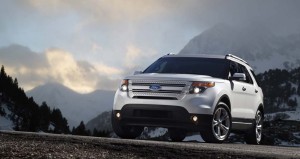
Early orders suggest the 2011 Ford Explorer will come out of the blocks strong when it goes on sale early next year.
It spent years at the top of the SUV sales charts before crashing, ignominiously, in the wake of a safety scare. But even before the completely redesigned 2011 Ford Explorer actually rolls into showrooms it’s showing strong signs of success.
With the new crossover-based version of the Explorer not set to roll into showrooms until early next year, Ford dealers have already booked 15,000 advance orders, twice what the maker was anticipating. And buyers appear to be opting for heavily loaded versions of the SUV, which could make the next-generation Explorer a significant source of profits for the resurgent Ford.
If the initial pace of orders holds steady it will serve as justification for the automaker’s risky decision to shift from a traditional, truck-based sport-utility vehicle to a car-like crossover.
Ford has been considering that strategy for some time but ultimately chose to stick with a body-on-frame design for the last Explorer. It might not have made much of a difference in the wake of an unexpected crisis triggered by reports that earlier Explorers were suffering unexpected and catastrophic tire blow-outs that could cause the vehicles to roll over. While sales initially held steady, demand for the Explorer eventually began to tank, and by 2009 volumes had plunged nearly 80%.
The safety scare was only part of the problem. The old Explorer was running up against significant new competition, both in the traditional SUV segment and from newer, car-like crossovers, which were rapidly becoming the hot ticket in the automotive market.
Today, crossovers handily outsell classic utes, but when it came time to design the newest Explorer, Ford was wary about making the switch. Part of the challenge was to make sure the replacement wouldn’t cannibalize from the maker’s other big CUV, the Ford Edge. The maker also needed to ensure that the 2011 Explorer maintained enough of the classic truck-based SUV’s capabilities to keep traditional buyers in the fold.
So, while the new model probably won’t handle some of the most severe trails it can still handle moderate off-road duties and tow a large trailer. And while it is a more sleek and stylish offering than boxy Explorers of the past, the 2011 Ford still looks like an SUV.
To overcome any lingering safety concerns, the maker is loading up on the latest features, adding such new safety technologies as Corner Control – which automatically slows the vehicle if a driver enters a turn too aggressively – and second-row seatbelts that incorporate airbags.
Meanwhile, by downsizing the Explorer engine line-up – not only dropping the traditional V8 but adding a 4-cylinder version of Ford’s EcoBoost engine – the maker hopes to get on the shopping list of buyers who would like a capable SUV while still cutting their fuel bills.
The initial batch of orders for Explorer show a promising trend for Ford, the Detroit News reports. Almost nine of ten buyers are opting for the new MyFord Touch infotainment system, while two in three are ordering all-wheel, rather than front-wheel-drive. Half are opting for navigation systems, and roughly the same number are ticking the box for trailer tow packages. Such features significantly drive up the average transaction cost of a vehicle – a trend Ford has seen with a number of other recent entries, including the latest Taurus and new Fiesta models.
Initial orders tend to be richer in mix than those that follow once a new vehicle has been on the road for awhile, but there are reasons to believe Explorer is in a good position to rebuild at least some of its once-daunting share. After plunging during the 2008 run-up in fuel prices, crossover and traditional utes have been steadily regaining ground and, now, collectively account for about a third of the overall American market.
The 2011 Ford Explorer is being produced at the same suburban Chicago assembly plant handling the Taurus. Sales forecasts are strong enough that the maker added a second shift earlier this month.
